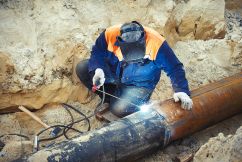What is TIG Welding?

What is TIG Welding?
There are a variety of processes that welders use to attach metals. The techniques are differentiated by the heat, equipment, and pressure that is used. One of the most common processes used is TIG welding.
Tungsten inert gas (TIG) welding is also referred to as Gas tungsten arc welding (GTAW). This is an arc welding process that produces the weld by utilizing a non-consumable tungsten electrode (an electrode that doesn't melt).
Both the electrode and the weld area are safe from oxidation and other contamination from the atmosphere. This is thanks to inert shielding gas such as helium or argon. In most cases, a filler metal is also used, and it is separately added to the weld pool.
TIG is great for precision and high-quality welding. That is why it is used when welding thin sections of nonferrous metals like copper, magnesium, and aluminum alloys or stainless steel. The process allows the service provider greater control when welding compared to other competing methods such as shielded metal arc welding.
Once the process is completed, the final product is a slag-free weld. It also has corrosion resistance properties similar to that of the parent metal.
TIG welding is preferred by service providers because it can be used to fuse more metal when compared to other processes. Therefore, it's also used in multiple industries. It started out in the aerospace industry, but now it's also used in the bicycle industry when welding tubes with small diameters and thin walls.
TIG is also used by auto manufacturers on fenders because of its anti-corrosive properties. Additional uses include welding wagons, door handles, lawnmowers, and bike frames. Keep in mind that it can be used in mechanized and manual welding.
The major advantages of this welding process include:
Allows control as the welder can regulate amperage and heat with precision
It is the go-to for weld seams with high-optical quality
No welding spatter is formed
It allows welding on all positions
TIG welding services can be offered both in-house and remotely. With mobile welding, clients experience convenience as they get to save up on time and costs that would have been spent travelling to the workshops.
All in all, it's important to keep in mind that the base metal and the arc of the flame are separated by a small space. Therefore, the welder should have a high degree of skill, which will ensure good hand-eye coordination and a great level of focus. Additionally, due to the low welding speed of this process, its time-consuming nature will require a lot of patience.
Produced by Mobile Welding StratfordFor more info call 226-779-5814
